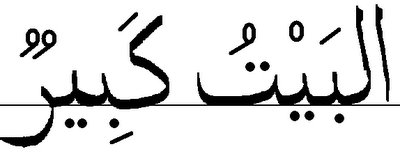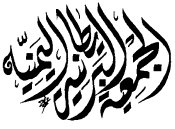Marhaba means Hello!
Mmmm...chocolate! Oh, yes, I almost forgot to read today's question:
"In what language was the Quran sent down?"
So picture it: it's the 7th century and Muhammed is sitting in a cave, on a spiritual retreat, when suddenly a glorious angel appears, opens its mouth and begins speaking in..."Arabic".
The words of the Quran were given in Arabic, and in Arabic they remain. Muslims proclaim that the Quran does not exist outside this original language form. Any translation, either in English or any other language, is neither a Quran, nor a version of the Quran, but rather is considered only a translation of the meaning of the Quran. If you want to read the real deal, you have to learn the language.
And that's precisely what many people do. There are about 200 million native speakers of Arabic in the world, but about 1 billion who have learned Arabic as a second language, or at least a portion of it, mainly because they follow Islam and want to read the scriptures and recite the prayers.
Arabic is a Semitic language. Remember the story of Noah and the ark? He built a big boat, filled it with lots of animals and was saved from the flood along with his children. One of his sons was named Shem, and it was from Shem's descendants that this group of languages is thought to have developed, so it was named the Semitic group. Also included in this branch of the "family tree" of languages are Hebrew and the mother tongue of Jesus, Aramaic.
Today Arabic has many forms. The modern language you would hear on the street in Cairo or Beirut is very different from the Classical Arabic of the Quran.
When reading or writing Arabic, you start from the right and move toward the left, the opposite of English. Arabic also uses a different alphabet than English, with 28 letters. It's easy to find contrasts between the two alphabets; Arabic has no "v" or "p" sounds, but it has letters called "ayn" and "ghayn", which have no equivalent in English.
Many words in our English vocabulary come from Arabic. A few examples: alfalfa, mattress, cotton, assassin, syrup, coffee, hazard, satin, sofa, and admiral.
I attached pictures of Arabic text, in case you wondered what it looks like. The first is a simple sentence, "the house is big". The other two are logos, where the Arabic letters are written in a way that forms a unique shape.

"In what language was the Quran sent down?"
So picture it: it's the 7th century and Muhammed is sitting in a cave, on a spiritual retreat, when suddenly a glorious angel appears, opens its mouth and begins speaking in..."Arabic".
The words of the Quran were given in Arabic, and in Arabic they remain. Muslims proclaim that the Quran does not exist outside this original language form. Any translation, either in English or any other language, is neither a Quran, nor a version of the Quran, but rather is considered only a translation of the meaning of the Quran. If you want to read the real deal, you have to learn the language.
And that's precisely what many people do. There are about 200 million native speakers of Arabic in the world, but about 1 billion who have learned Arabic as a second language, or at least a portion of it, mainly because they follow Islam and want to read the scriptures and recite the prayers.
Arabic is a Semitic language. Remember the story of Noah and the ark? He built a big boat, filled it with lots of animals and was saved from the flood along with his children. One of his sons was named Shem, and it was from Shem's descendants that this group of languages is thought to have developed, so it was named the Semitic group. Also included in this branch of the "family tree" of languages are Hebrew and the mother tongue of Jesus, Aramaic.
Today Arabic has many forms. The modern language you would hear on the street in Cairo or Beirut is very different from the Classical Arabic of the Quran.
When reading or writing Arabic, you start from the right and move toward the left, the opposite of English. Arabic also uses a different alphabet than English, with 28 letters. It's easy to find contrasts between the two alphabets; Arabic has no "v" or "p" sounds, but it has letters called "ayn" and "ghayn", which have no equivalent in English.
Many words in our English vocabulary come from Arabic. A few examples: alfalfa, mattress, cotton, assassin, syrup, coffee, hazard, satin, sofa, and admiral.
I attached pictures of Arabic text, in case you wondered what it looks like. The first is a simple sentence, "the house is big". The other two are logos, where the Arabic letters are written in a way that forms a unique shape.




0 Comments:
Post a Comment
<< Home